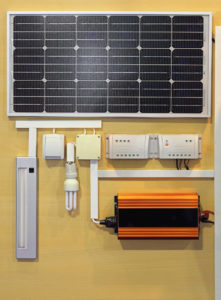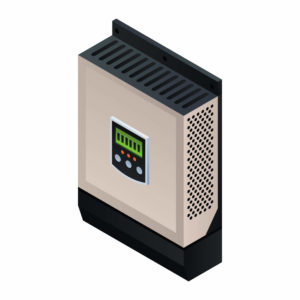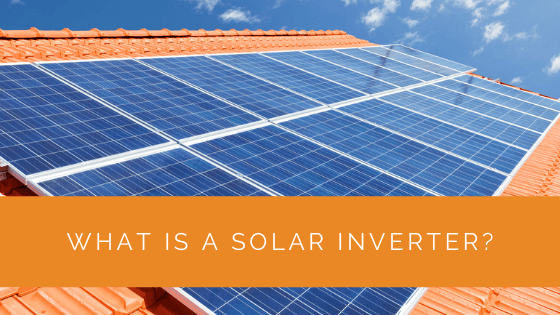Choosing an excellent solar inverter is vital for your solar PV system.
This is not as simple as it looks. There are many inverters to choose from, and each one brings something unique to the table.
Here is a breakdown of what the inverter does and what the variations are.
Contents
- 1 Key Takeaways
- 2 What Is a Solar Inverter?
- 3 How Does a Solar Inverter Work?
- 4 How Much Does a Solar Inverter Cost?
- 5 Types of Solar Inverters
- 6 What Are the Benefits of Solar Inverters?
- 7 Case Study: Optimizing Solar Inverter Selection for Maximum Efficiency
- 8 Expert Insights From Our Solar Panel Installers About Solar Inverters
- 9 Experience Solar Excellence with Us!
- 10 Conclusion
Key Takeaways
- A solar inverter plays a crucial role in a solar PV system by converting direct current (DC) output from solar panels into usable alternating current (AC) electricity for appliances.
- Solar inverters have evolved to offer advanced functionalities, including data management, utility controls, and system design engineering, making them essential for efficient solar energy systems.
- There are different types of solar inverters, such as string inverters, microinverters, power optimizers, and hybrid inverters, each with its advantages and limitations in terms of cost, efficiency, and layout compatibility.
What Is a Solar Inverter?
Solar inverters are an underrated component of a solar energy system. They have an integral role in how the system works. They are known as the brainpower behind the system and how it all comes together. It doesn’t matter how large the system is or what it is powering, the inverter will play a significant role in its performance.
The inverter is designed to invert the DC (direct current) output into the AC (alternating current). The AC is a standardized current that is used for all types of appliances. The inverter has to “invert” the current between the system and the appliance for the energy to go through.
In recent times, inverters have developed tremendously. These units do a lot more than just invert DC to AC. They can do a series of things simultaneously, including how the rest of the system is running. It can help manage data, handle advanced utility controls, and even help with system design engineering. It is all about creating a refined machine that is easy to maintain throughout the year.

How Does a Solar Inverter Work?
Let’s assume a solar PV system has been installed.
The sun will power the system, and then the solar cells are going to go to work. The power that is going to be generated by the cells will be direct current (DC) energy. This is energy that is going to sit inside the cells.
The inverter is then going to act as a transitional part for the current. The home is going to need AC energy for the electricity to be usable.
As a result, the inverter is going to change the current from DC to AC. This is why any power that will come through the unit will be effective and power everything.
How Much Does a Solar Inverter Cost?
The cost tends to come somewhere between $1,000 to $1,500 depending on the size of the unit. In commercial systems, the price can go past this number.
In most cases, solar installers will look at the number of watts that the system will produce. They will then use a set rate from there of approximately $0.18 per watt.
It’s important to note the inverter is just one part of the system, and the other parts will be far more expensive. In fact, the inverter will only be 6-7% of the total cost when everything is said and done, including the installation expense.
This is something to keep in mind when installing a solar PV system for your home.
It is rare for the cost of the inverter to go past the 10% mark within a system. This is simply not going to happen because of how costly the other parts are and how prices are added up. It is recommended to reach out to a specialist when it is time to buy an inverter, including asking for a price breakdown.
Types of Solar Inverters
String Inverters
This is a common sight with smaller solar energy systems. A string inverter is a centralized unit in a solar PV system. This means each panel is going to be interlinked using a string.
These strings are going to go up to three and will be linked directly to the central inverter. As soon as the panels produce energy, all of it is going to be directed via the strings to the central inverter. This tends to be located on the side of the house, but it can be located in other areas, such as the basement or garage. This inverter is going to be responsible for converting DC to AC energy.
The benefit of using a string inverter has to do with affordability and durability. It is going to last for a long time and is quite affordable.
However, you are going to have to deal with a less efficient solar energy system. It will not be as quick, and it might become difficult to handle in a more complex layout.
This is a good option for those who want a straightforward inverter that is going to be affordable. It is a good choice for smaller properties.
Microinverters
This is a type of inverter that is going to have a distributed layout. This means each solar panel will install a separate inverter to handle the energy coming through. This ensures the energy doesn’t have to travel a long distance to get to where it needs to be.
The energy is converted right on the spot, making it far more efficient.
This is ideal because it is faster, simpler, and more effective. It tends to work well for complicated layouts where the panels will not be in one spot.
On the other hand, it will be a costly investment compared to a string inverter. This is something to keep a note of.
This is a good option for those going to have solar panels on different sides of the property. This ensures the system can be fully maximized as intended. For example, if there is shade in one spot and the panels need to be moved to another part of the property. The microinverter is going to be a good fit as it will optimize the layout of the property and still produce a good amount of DC electricity.
This is key when it comes to going with an efficient option for your needs.
Power Optimizer
This is a specific type of inverter that tends to come in between a string and a microinverter.
In this case, the power optimizer will be set up on the roof next to the solar panels. However, the system is still going to be linked to a separate centralized inverter.
These power optimizers are not designed to convert DC to AC electricity near the solar panel. Instead, it is responsible for conditioning the DC electricity by normalizing its voltage as soon as it hits the panel. This makes it ready to go as soon as it gets to the string inverter.
This is a system that is used because it can improve how efficient the solar PV system is. If there is regular shading, this improves how much energy is getting through. It will also avoid wasting time.
The one issue that is going to be seen with power optimizers would be the cost. This is a costly investment because there are additional components involved that are not seen with other units. This also makes them harder to maintain because each unit is separate from the others.
This is only good for those who don’t have a simple layout and are willing to pay more to get a more efficient setup.

Hybrid Inverter
This is an inverter that is focused on using a battery. It takes components of a battery and solar inverter to create a two-tiered solution.
This means the solar system will process the DC electricity that is coming from the panels. However, the battery inverter will act as a backup if enough energy is not coming through as intended.
The reason to do this is to avoid having to install a separate battery inverter in the house. This is going to be an all-in-one unit that can do both at the same time.
What Are the Benefits of Solar Inverters?
Increases Efficiency
It all comes down to efficiency and making sure the electricity is usable.
DC electricity that is produced by the solar panel is not useful. It is not going to work with anything inside the house. This is why the inverter is important as it will convert the electricity and make sure it adds value to the property.
This is why it is one of the most important parts of the solar PV system.
Helps Monitor the System
If there is anything inefficient about the system, the inverter will let you know.
All of the electricity is going through to this part of the system. As a result, it is going to be the brainpower of the unit.
Just having this setup makes a difference. The system can be tracked down to a specific solar panel depending on which type of inverter is being used.
Case Study: Optimizing Solar Inverter Selection for Maximum Efficiency
Background
Solar Panels Network USA was approached by a residential client who wanted to maximize the efficiency of their new solar PV system. The client was particularly interested in ensuring the system would not only meet their energy needs but also offer advanced monitoring and management capabilities.
Project Overview
The primary goal was to select and install a solar inverter that would enhance the overall performance of the solar PV system. The client’s property had a complex roof layout with multiple shading issues, which necessitated a thoughtful approach to inverter selection.
Implementation
- Assessment and Requirements Gathering: We started with a comprehensive site assessment to understand the specific challenges posed by the property’s layout and shading patterns. The client’s energy usage patterns were also analyzed to tailor the system to their needs.
- Inverter Selection: Based on the assessment, we recommended a combination of microinverters and power optimizers. This hybrid approach was chosen to address the shading issues effectively while maximizing energy conversion efficiency.
- Installation: The microinverters were installed on each solar panel to ensure localized conversion of DC to AC power, minimizing losses due to shading. Power optimizers were integrated to further enhance voltage regulation and system performance.
- System Integration and Monitoring: Advanced monitoring systems were integrated with the inverters to provide real-time data on energy production and system health. This setup allowed the client to track performance and quickly identify any issues.
Results
- Increased Efficiency: The hybrid inverter setup significantly increased the system’s efficiency, especially in areas prone to shading. The localized energy conversion by microinverters ensured that shading on one panel did not affect the performance of the entire system.
- Enhanced Monitoring: The client now has access to detailed performance data, enabling proactive maintenance and swift troubleshooting. This has ensured the system operates at peak performance consistently.
- Optimized Energy Production: By using a combination of microinverters and power optimizers, the system maximized energy production even under less-than-ideal conditions, ensuring the client’s energy needs were met year-round.
- Long-Term Reliability: The advanced functionalities of the chosen inverters, including data management and system diagnostics, have provided the client with a reliable and robust solar energy solution.
Summary
This case study highlights the importance of selecting the right inverter to address specific site challenges and optimize solar PV system performance. By combining microinverters with power optimizers, Solar Panels Network USA was able to deliver a highly efficient, reliable, and manageable solar solution tailored to the client’s unique needs.
Expert Insights From Our Solar Panel Installers About Solar Inverters
A solar inverter is not just a component; it’s the heart of the solar PV system. Choosing the right inverter ensures that your system runs efficiently and reliably, converting the solar energy into usable electricity for your home.
Lead Solar Installer
The evolution of solar inverters has made them indispensable, with advanced functionalities like data management and system diagnostics. These features help in maintaining the system’s performance over time.
Senior Solar Technician
Understanding the different types of inverters, from string inverters to hybrid models, allows homeowners to make informed decisions based on their specific energy needs and layout constraints.
Solar Energy Consultant
Experience Solar Excellence with Us!
Trust in Solar Panels Network USA, where our seasoned experts deliver top-quality solar solutions for homes and businesses nationwide. With a legacy of countless successful installations and a commitment to sustainable energy, we’re your reliable partner in the solar journey. Ready for a brighter, eco-friendly future? Call us now at (855) 427-0058 and harness the power of the sun!
Conclusion
In the end, the inverter is a noteworthy investment and the heartbeat of the system. It needs to be perfect, or the system will fall apart before it ever gets a chance to get going.
It is essential to invest in the best possible fit for your property and its layout.
About the Author
Solar Panels Network USA stands at the forefront of solar energy solutions, driven by a team of seasoned solar engineers and energy consultants. With over decades of experience in delivering high-quality solar installations and maintenance, we are committed to promoting sustainable energy through customer-centric, tailored solutions. Our articles reflect this commitment, crafted collaboratively by experts to provide accurate, up-to-date insights into solar technology, ensuring our readers are well-informed and empowered in their solar energy decisions.

